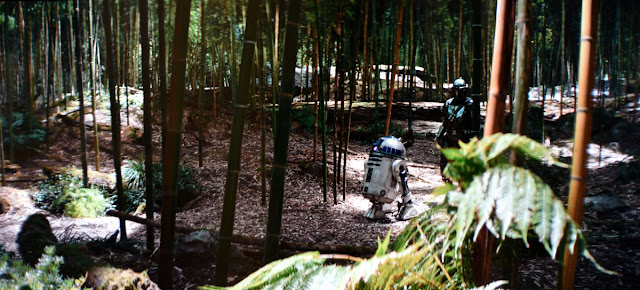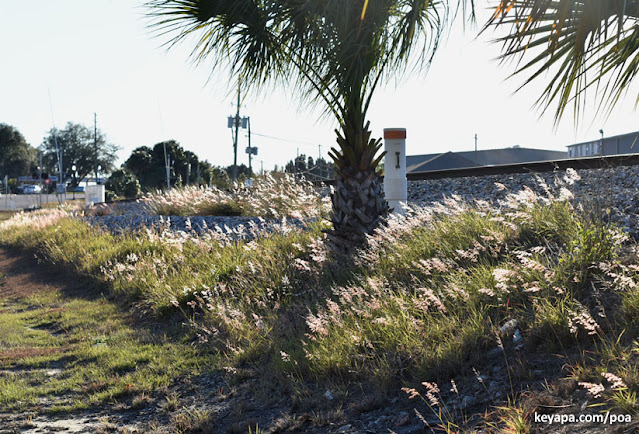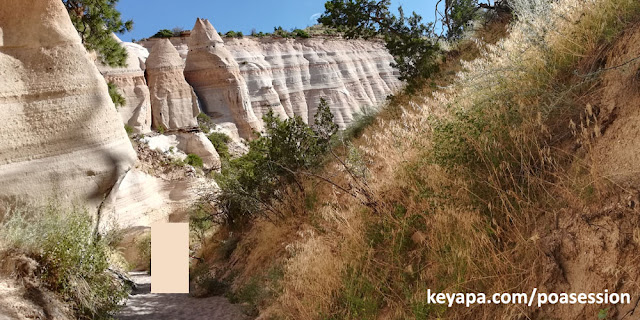
SPOILERS WARNING!
Do not read if you are about to watch episode 6 of the Boba Fett Saga.
What a great episode in the new Star Wars series on Disney Plus!
Not only did we get to see many of the major characters in Star Wars come back, but the setting for most of the new episode is on a planet that seems to be dominated by various bamboo species!
In this episode, the Mandalorian travels to where he believes Luke Skywalker has taken Grogu.
When he lands, the first thing he meets is the venerable R2-D2, who guides him through a bamboo forest to a clearing, where ant-like robots are building what looks to be a stone structure.
 |
| R2-D2 guides the Mandalorian |
When the Mandalorian presses him on the whereabouts of Grogu, R2-D2 shuts down and the Mandalorian is forced to rest on a bench that the ant-like robots made for him using stones and bamboo poles.
 |
| The bamboo bench |
Meanwhile, we cut to Luke Skywalker and Grogu in the bamboo forest. Luke is teaching Grogu how to become a Jedi, and there are many scenes of them in various settings surrounded by bamboo.
In one scene, they are walking along a trail through the bamboo forest, and Luke asks Grogu whether he wants to remember what happened to him in the past. When Grogu seemingly gives assent, Luke places his hand on top of Grogu and we suddenly see scenes of battle, with Clone Troopers killing Jedi and Grogu staring in horror at the devastation.
 |
| Luke Skywalker and Grogu walking along a bamboo grove |
In another scene, Luke takes Grogu on his shoulders, just like he did Yoda when he himself was being trained as a Jedi, and Luke runs through a forest filled with huge bamboos, before climbing nimbly up to the top of the canopy.
 |
| Luke Skywalker climbing up bamboo stand with Grogu on his shoulders |
There Luke tells Grogu about the Force, and how the world exists in balance, and that through the Force Grogu will find balance as well. It is a moving moment, with the two staring out towards the wider world, and bamboo leaves fluttering around them in the breeze.
 |
| Feeling the Force |
Finally, we cut to a small clearing surrounded by gigantic bamboo, and we see Grogu balancing successfully on a bamboo culm, while Luke draws his lightsaber and displays his swordsmanship. It is another moving moment in an episode with so many deep emotional currents.
 |
| Grogu balancing on a bamboo culm |
My favorite character Ahsoka Tano then suddenly shows up. There is no fanfare, no big reveal. The Mandalorian suddenly realizes he is not alone, and when he stands quickly from his rest and draws his gun, he is confronted by Ahsoka, who is casually leaning on some bamboo culms and waiting for him.
 |
| Ahsoka Tano talks to the Mandalorian |
She tells him that the structure being built is going to be a new Jedi temple, and that Grogu will be its first pupil. When the Mandalorian insists on seeing Grogu, she leads him through the bamboo groves and tells him he has the option of seeing Grogu, but that this meeting would only cause more difficulty for the child. After some thought, the Mandalorian decides that he will not see Grogu, but he asks Ahsoka to give the child a suit made from Mandalorian armor.
Near the end, we see Ahsoka and Luke talking by a lake, bamboo trees behind them, as Luke asks her what he should do with Grogu. Ahsoka responds that he should trust his instincts, and when she turns to leave, Luke wonders whether he would see her again. She says "perhaps" and wishes him farewell in that most time honored of fashion: "May the Force be with you."
 |
| Luke Skywalker |
The continuous use of scenes with bamboo in this episode is likely not accidental.
In many Asian cultures, bamboo symbolizes harmony and balance, mainly due to the fact this grass features an unmatched combination of flexibility and strength in the structure of its culm. This is analogous to the balance that Luke tells Grogu is inherent in the Force. George Lucas had been heavily influenced by Eastern mysticism in his creation of the Star Wars Jedi ethos, and especially by Taoism, and the series continues to hew to this bias by using bamboo as the primary setting for Grogu's training.
The fact that the planet will also be home to the new Jedi Temple is also heavily symbolic. Bamboos are the fastest growing plants in the world, and they can also be used to symbolize the nascent growth of the Jedi after their decimation by the Sith Emperor.
I cannot emphasize enough how cool this episode was, not only because of the introduction of many of the most beloved characters in the Star Wars universe, but also because of the many beautiful scenes of bamboo that surrounded (and perhaps defined) them.
Go watch it!































